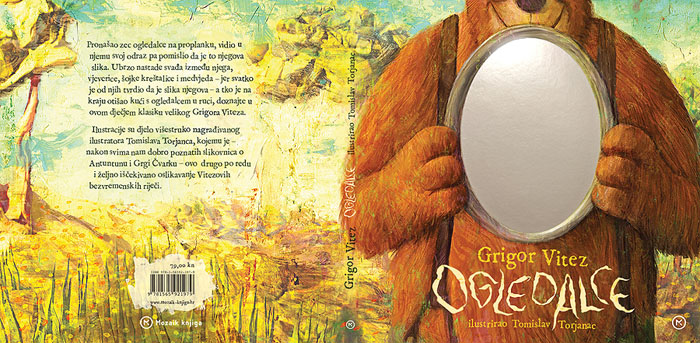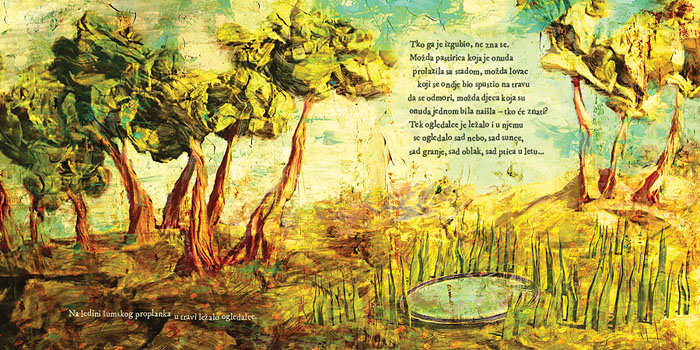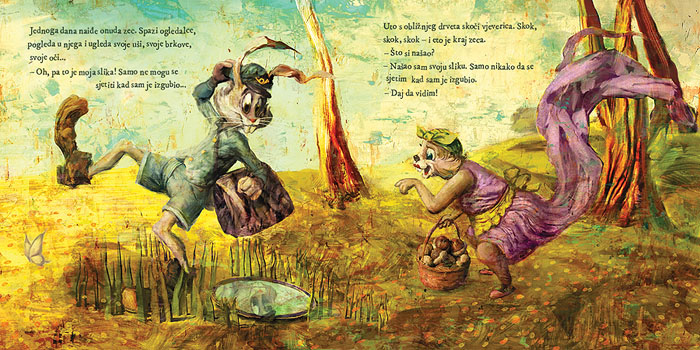


|
|
The Little Mirror /
Ogledalce
Grigor Vitez, Tomislav Torjanac (illustrator)
Mozaik knjiga (HR) 2016.
| EN Like Antuntun before it, The Little Mirror picture book is based on the classic text by Grigor Vitez, first published in 1965. |
|
HR Kao i Kako živi Antuntun, slikovnica Ogledalce nastala je prema klasičnom tekstu Grigora Viteza, prvi put objavljenom 1965. |

| The Little Mirror, front and back cover |
|
Ogledalce, naslovnica i zaslovnica |
| The
front cover shows the little mirror from the story, with reflective
foil applied onto its surface, so kids can actually see their reflection
in it. Apart from the obvious allusion to the picture book’s title, by
using this device I tried to invite children to become a part of the
story. |
|
Naslovnica
slikovnice prikazuje ogledalce na čiju je površinu aplicirana
reflektirajuća folija u kojoj čitatelji mogu uistinu vidjeti svoj odraz.
Osim očite aluzije na naslov, tim sam efektom nastojao potaknuti djecu
da i ona postanu dio priče. |

| The Little Mirror, pages 2-3 |
|
Ogledalce, stranice 2-3 |
| The
story begins when the hare comes across the little mirror in a forest
clearing and, upon seeing his reflection in it, thinks it is his
picture. Soon, a quarrel arises between him, the squirrel, the jay and
the bear, because they each claim it's their picture. Guess – or better
yet, read – who eventually took the little mirror home with them, and
what happened to it. |
|
Priča
počinje tako da zec pronađe ogledalce na proplanku i, vidjevši u njemu
svoj odraz, pomisli da je to njegova slika. Ubrzo nastane svađa između
njega, vjeverice, šojke kreštalice i medvjeda jer svatko od njih tvrdi
da je slika njegova. Pokušajte pogoditi – ili, još bolje, pročitajte –
tko je na kraju otišao kući s ogledalcem u ruci i što je s njim učinio. |

| The Little Mirror, pages 4-5 |
|
Ogledalce, stranice 4-5 |
The
animals in the story share a common trait with children, who –
encountering something unknown to them – give it the most obvious and
the simplest of meanings, “unspoiled” by life experience that comes with
becoming an adult. This is one of the main reasons for the timelessness
of the Vitez's text, and an additional reason for the aforementioned
reflective foil on the cover.
Visually, the major part of the picture book functions as a
series of scenes from a theatrical play – an art form children are
familiar with at a very early age – with characters who, one after
another, enter the “stage”, i.e. the forest clearing with the mirror
lying in the grass and with trees in the background. |
|
Grigor
Vitez dao je životinjama u priči psihološke odlike djece, koja pri
susretu s nečim nepoznatim tomu pridaju njima najočitije i
najjednostavnije značenje, “neokaljano” životnim iskustvima iz svijeta
odraslih. To je jedan od glavnih razloga za bezvremenost Vitezova
teksta, ali i dodatan razlog za postojanje spomenute reflektirajuće
folije na naslovnici.
Vizualno, veći dio slikovnice funkcionira kao niz prizora iz
kazališne predstave – oblika umjetnosti koji je djeci poznat u vrlo
ranoj dobi – s likovima koji jedan za drugim ulaze na “pozornicu”,
odnosno proplanak s ogledalcem u travi i s drvećem u pozadini. |

|
|
|
|
|
|